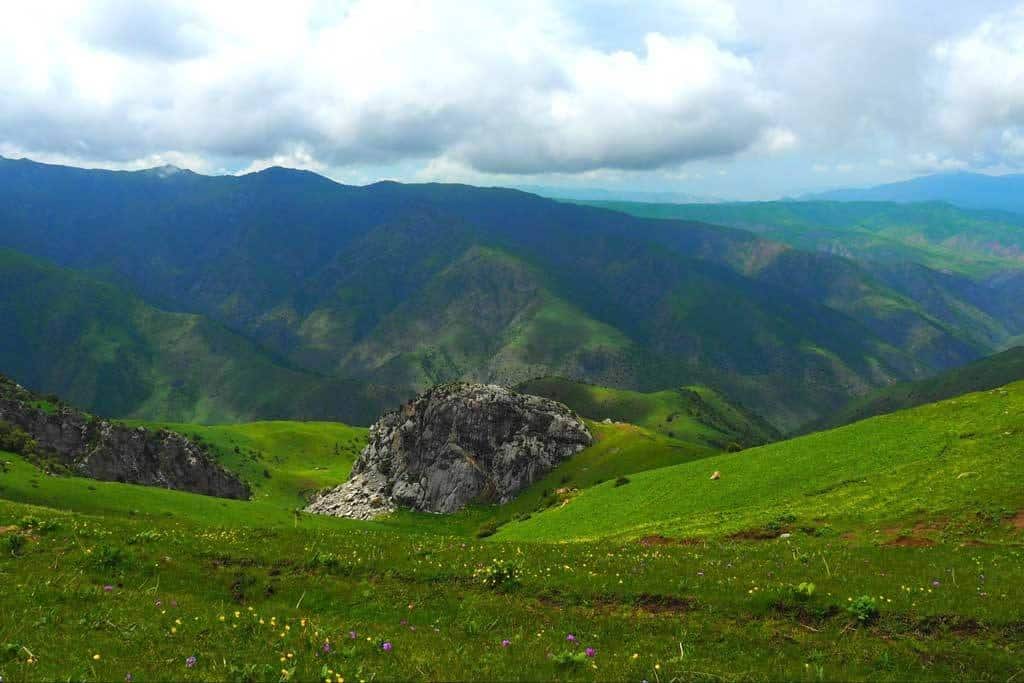At a taxi stop under a bridge, I waited for the van to fill up. The cars were packed in like jigsaw pieces, honking and yelling to shimmy free.
My taxi driver Almaz sold kymyz (a mildly alcoholic traditional Kyrgyz drink made from fermented horse milk) from gallon jugs in his trunk.
People came with empty Coke and Fanta bottles to be filled with the milky bubbling black speckled brew.
Between chatting with the other drivers, Almaz would say five more minutes, every ten minutes.
He gave me a bottle of kymyz to pass the time. After two hours, the taxi was packed with grandparents, small children, and bread, and we were on our way.
READ MORE: Here’s our complete guide to help you travel to Kyrgyzstan!
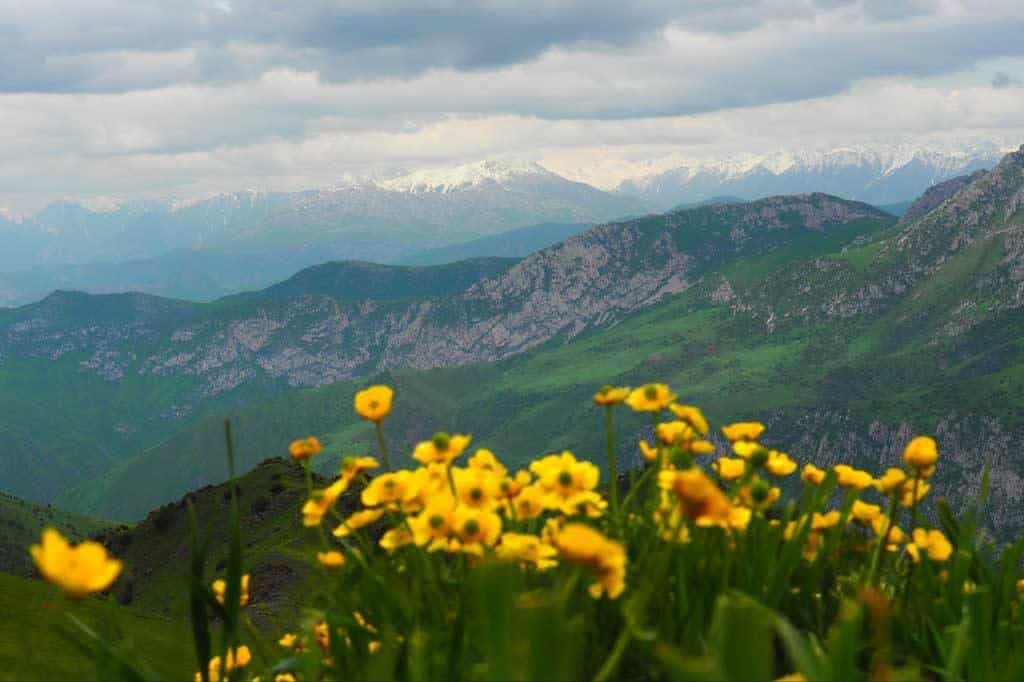
Table of Contents
The ‘Be a Nomad’ Trekking Guide
The Be a Nomad trek offered by the Osh Alay CBT is a three-day, two-night hike, that can be done either on horseback or on foot.
The trek goes from Kara Bulak to Chychyk and can be done in either direction.
On both nights of the trek, travellers are hosted in yurts, at Sari Oi and Kok Bell jailoos.
This adventure gives people a chance to experience both the natural beauty of the Kyrgyz landscape, with its rolling green hills, snow-capped mountains, and red rocks, as well as the nomadic heritage of the Kyrgyz people still alive in the summer jailoo tradition.
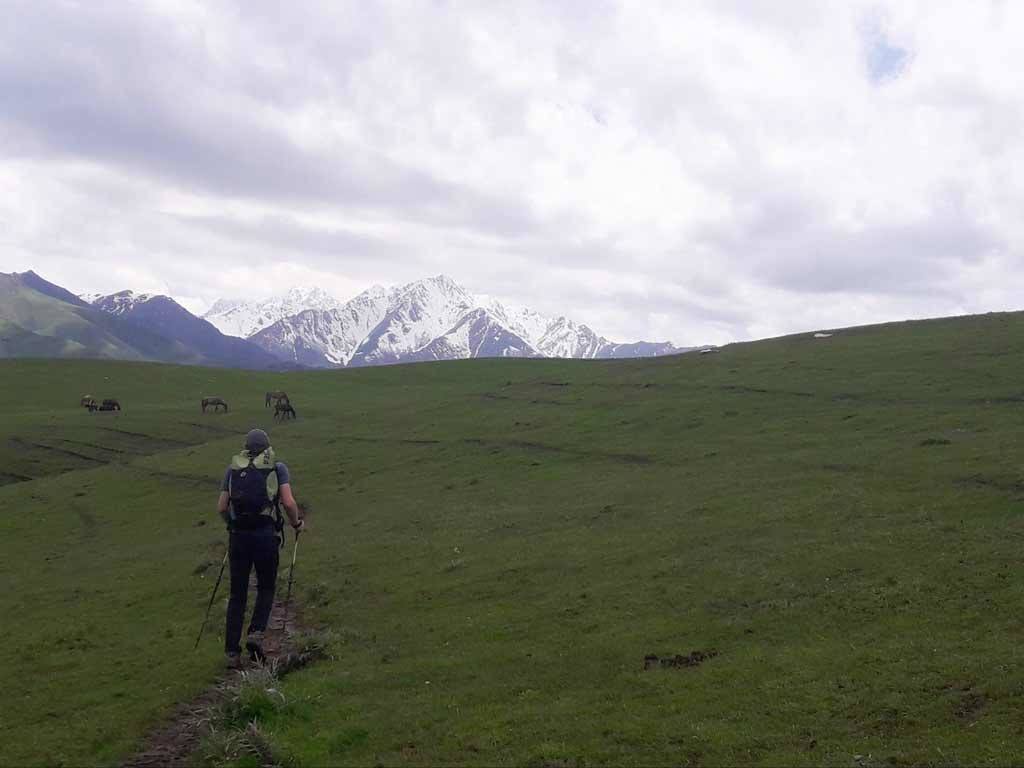
Generally, hikers are accompanied by a guide on this trek to help communicate with homestay families and navigate the maze of footpaths made through the mountains by wanderings of grazing animals.
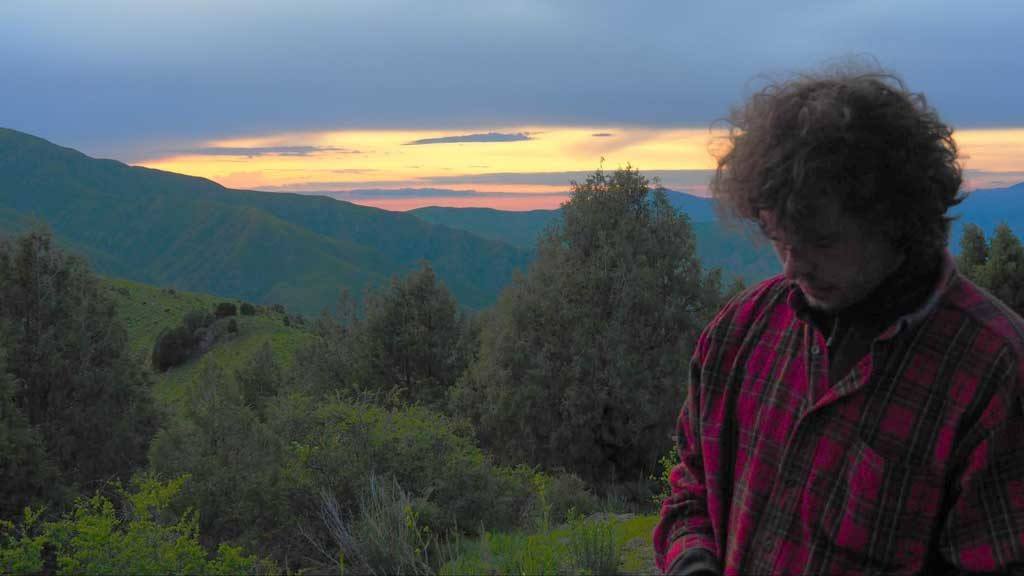
My limited knowledge of the Kyrgyz language afforded me the opportunity to traverse this beautiful range without a guide.
While there were no real problems concerning communication, I found myself lost often and questioning my direction nearly always.
Grazing animals have been making misleading trails through these mountains for thousands of years, and as a result, sometimes the way to go is not the most obvious.
A conversational grasp of Kyrgyz or Russian is preferred, but it is probably best to be joined by a local guide when exploring this part of the world.
READ MORE: Love trekking? Don’t miss the Keskenkija Loop in Jyrgalan!
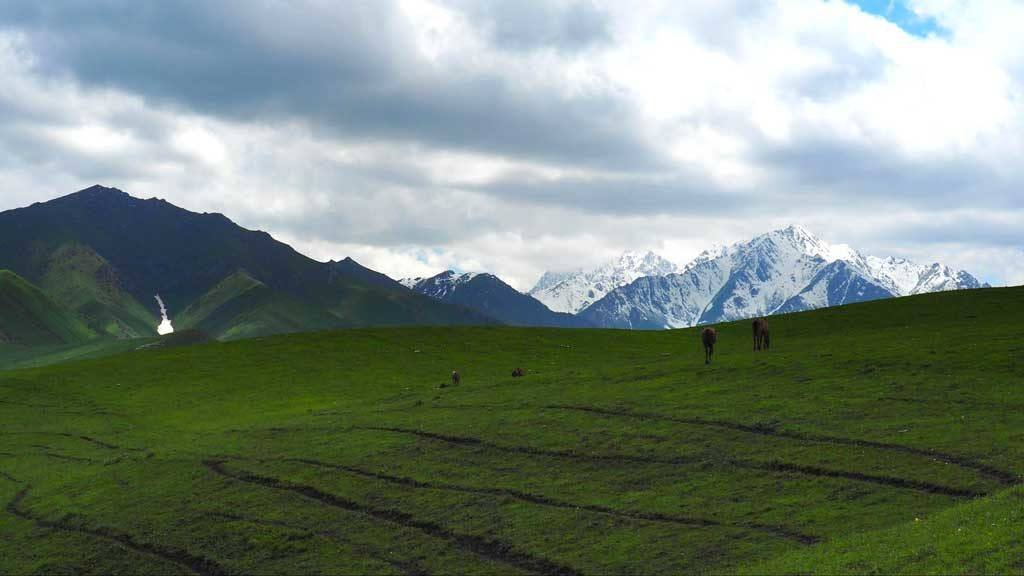
Day One: Chychyk to Sari Oi
The shared taxi drive from Osh City to Chychyk along the Pamir Highway is long and cramped.
The roads are steep and narrow. They twist.
Our driver Azamat weaved back and forth between oncoming traffic and slow-moving porters loaded with horses and sheep, churning the kymyz in my belly.
Most taxi drivers do not go to Chychyk, but pass it on their way to Gulcha.
When looking for a taxi to the trailhead find drivers going to Gulcha and ask them to stop in either Chychyk or Kara Bulak.
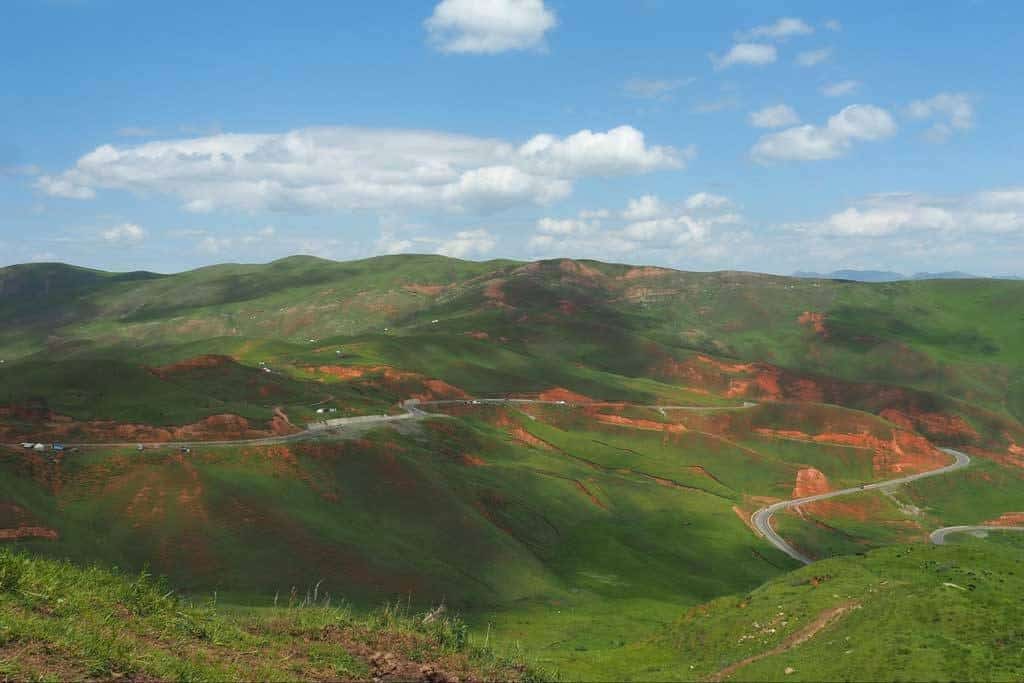
At Chychyk there is a sign marking the start of the trail on the side of the road, near a large silver arching monument, and a muddy unpaved car road that snakes up and through the foothills of the Asan Korgon Mountains.
You pass roadside yurt camps where men drink kymyz and call out to passers-by.
Soon I found myself in a green bowl faced with a wall of red rock and shale.
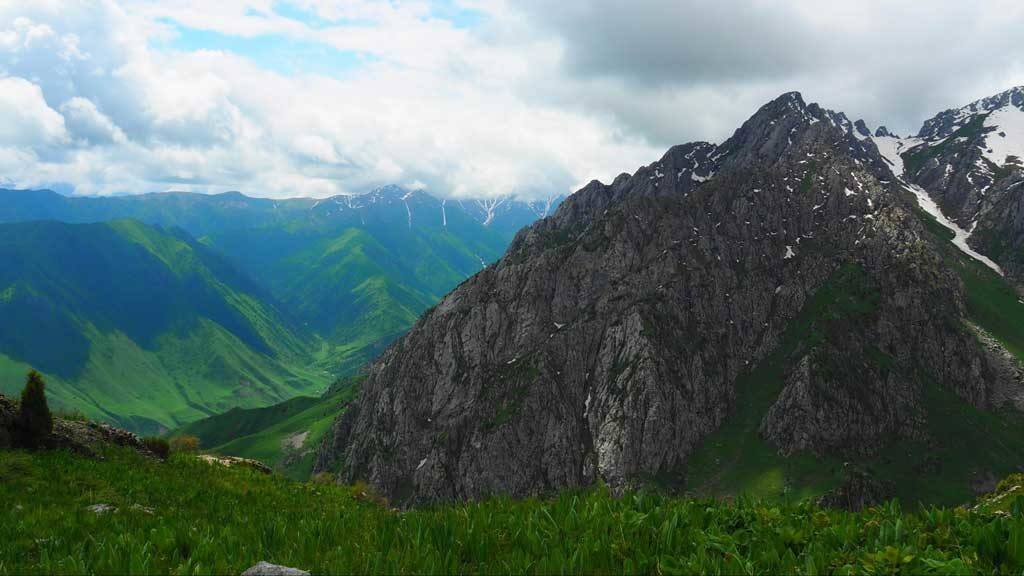
The climb was steep and the sun was hot. The shale was crumbled and loose.
The incredible green of the fields below was shocking in contrast with the red rocks and made me grateful for a reprieve from the spring rains that make such saturated colour a reality.
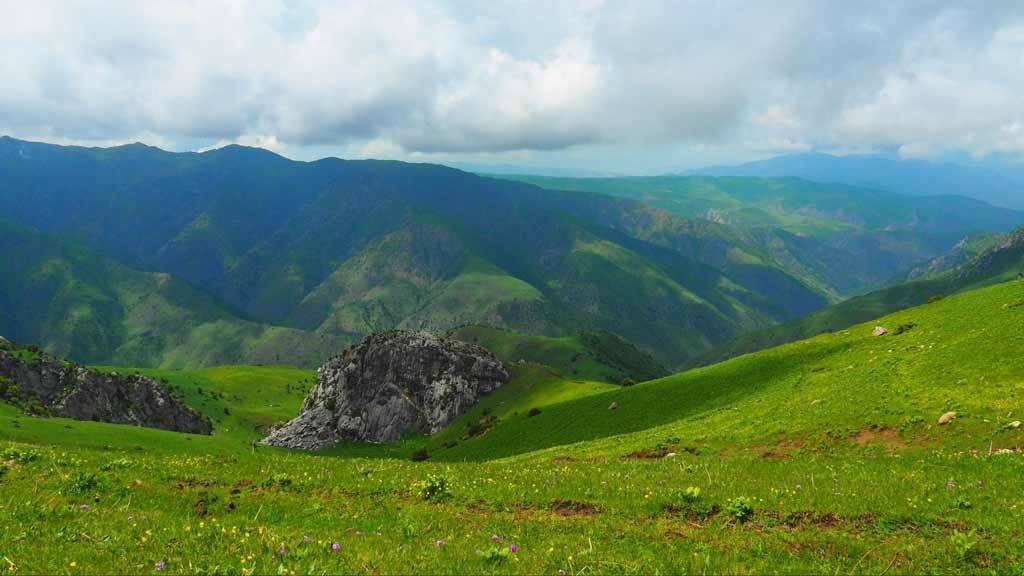
At the top of the ridge, I sat and ate sunflower seeds, while the kymyz settled, and talked with a man on horseback.
He pointed me to the southeast, in the direction of growing rain clouds and Sari Oi—he said it would rain for five days.
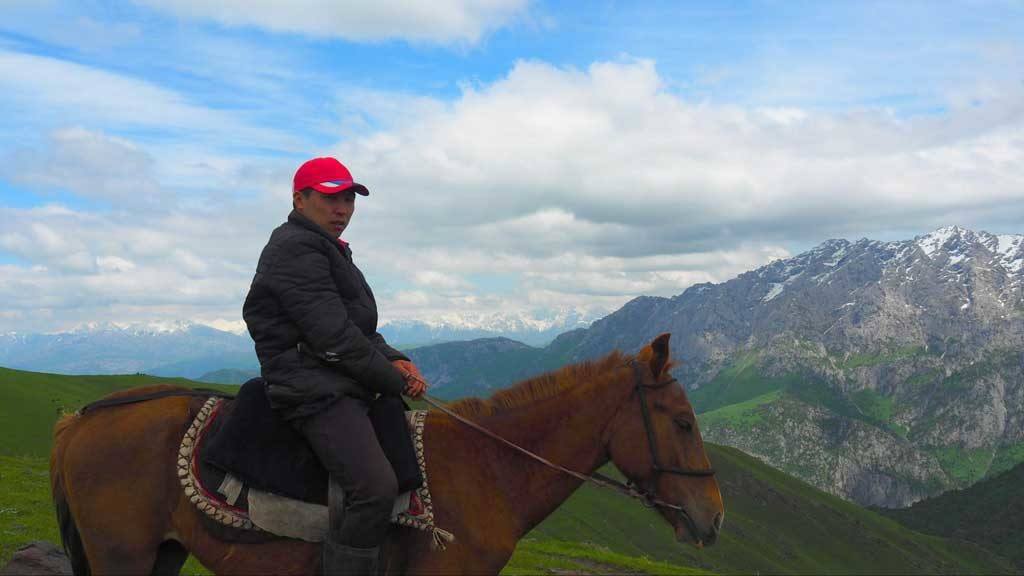
Traversing down the backside of the mountain, it seemed certain that the green pastures of Sari Oi speckled from afar with white yurt spots would appear over the next ridge.
But three times I was disappointed and pressed on.
Over the fourth ridge, the camp came into view, but the hike down was long and hard on the knees.
On the way to Sari Oi I met an old man with a bundle of sticks.
He laid on the side of the mountain and spoke in Russian, either ignoring or oblivious of my attempts to converse in Kyrgyz.
I shooed territorial cows and walked past a young shepherd pulling up his pants from a fresh squat.
He asked if I had seen his friends, and I told him about the old man. He nodded.
Eventually, the hills receded to open pastures and clusters of yurts and tents and I walked through the hand-made gate of Aiperi and Bekish’s home at Sari Oi Jailoo.
READ MORE: Everything you need to know about the Boz Uchuk Trek in Jyrgalan!
I was greeted with much hospitality. Together we drank more kymyz and spoke of the beauty of the nearby mountains.
They told me that nature was the best place to raise children as they looked lovingly at their four smiling daughters.
The yurt at Aiperi’s camp in Sari Oi is incredibly beautiful, decorated with many felt-work handicrafts made by Bekish’s mother.
The family is warm and happy, and the toilet has a seat. It was an incredibly comfortable place to spend the night.
They even had a solar panel on the outside of the yurt that powers a lightbulb.
While the wind blew and the rain battered the wool wrapped yurt, I was warm and comfortable thanks to pounds of tyshyks (intricately decorated comforters filled with sheep wool).
The pacifying effect of the kymyz fell heavy on my eyelids.
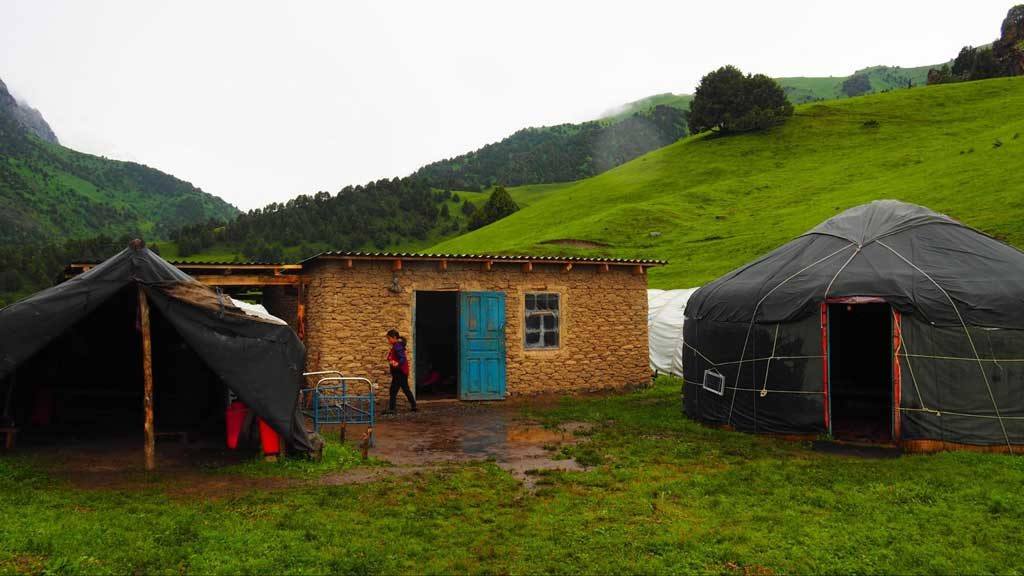
Day Two: Sari Oi to Kok Bell
The rain persisted through the night and grew harder in the morning.
Aiperi bid me not to go. She feared I would get sick and lost.
It was difficult to leave the warm hospitality of Aiperi and her family, and even harder to leave the warm embrace of my tyshyk bed inside the protection of the yurt.
I assured her I had warm clothes and a map and set off towards Kok Bell in the rain.
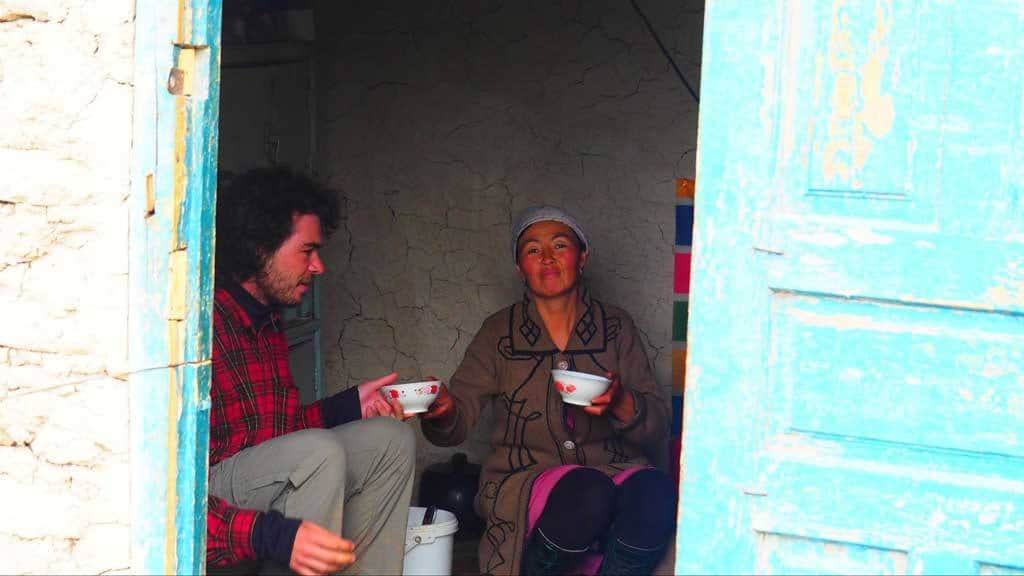
From Sari Oi I slid down an unpaved car road, dodging tire spinning Ladas and running from angry jailoo dogs.
At the river, I turned right and the climb to Kum Bell Pass began. In the rain, the green was expansive and vibrant, almost overwhelming.
As I moved higher, traversing the mountainside of cow paths and bushwhacked tangents, the skies grew darker and the rain fell and fell.
When stubborn cows stood in the way, I yelled and shook my poles, “Yah! Yah! Yah!”
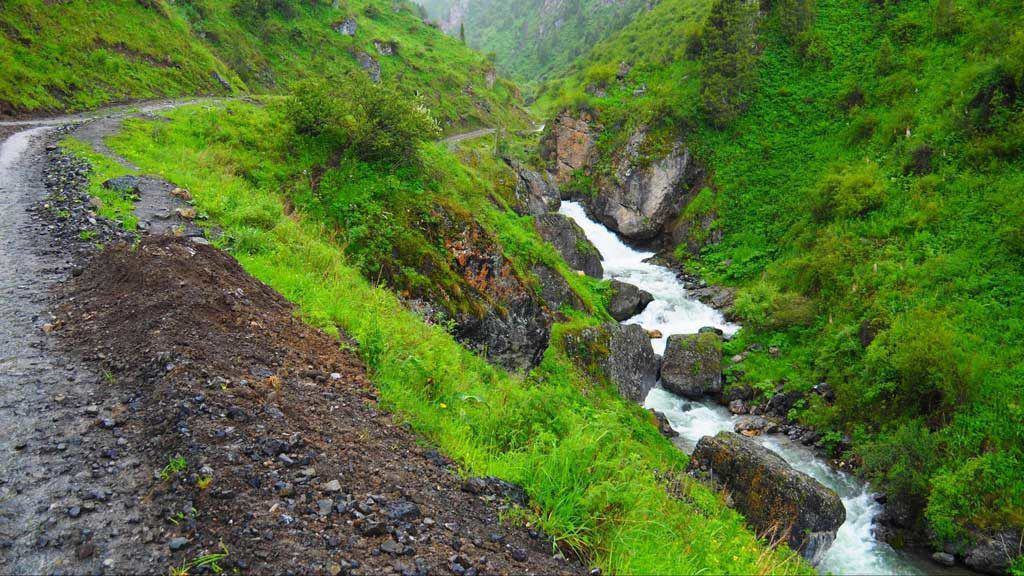
The green grass gave way to red and grey rock, and I scrambled higher and higher over the pass.
Sun sucking black clouds swirled the skies. Rain and hail fell. The wind whipped at my face.
The slope inched closer and closer towards a 90-degree angle. Near the top, I scrambled the last few hundred meters on my hands and feet.
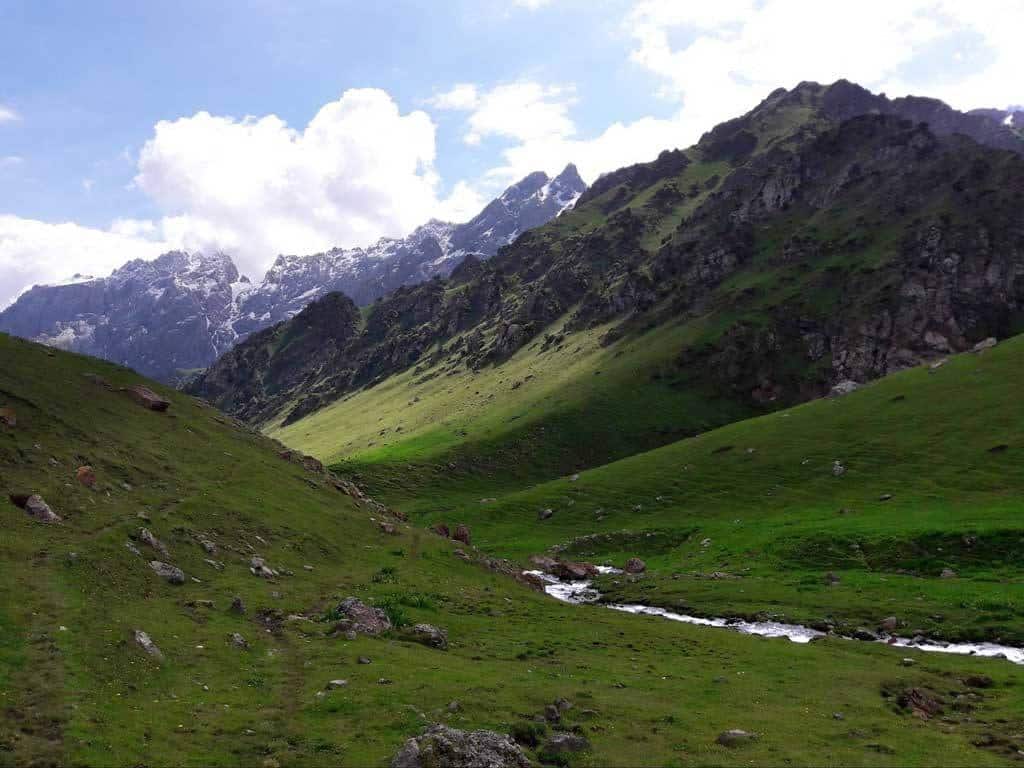
From the top of the pass, the next destination came into view, the smaller yurt camp nestled in the pasture of Kum Bell.
The descent was treacherous, even as the rain began to wane. The slope was steep and the rocks were slick.
For much of the way, I slide down carefully, using my hands as support.
Loose rocks at my feet gave way, tumbling down and shattering on the ground.
Going was slow until the terrain evened out into the pasture and the green retook the land from the grey.
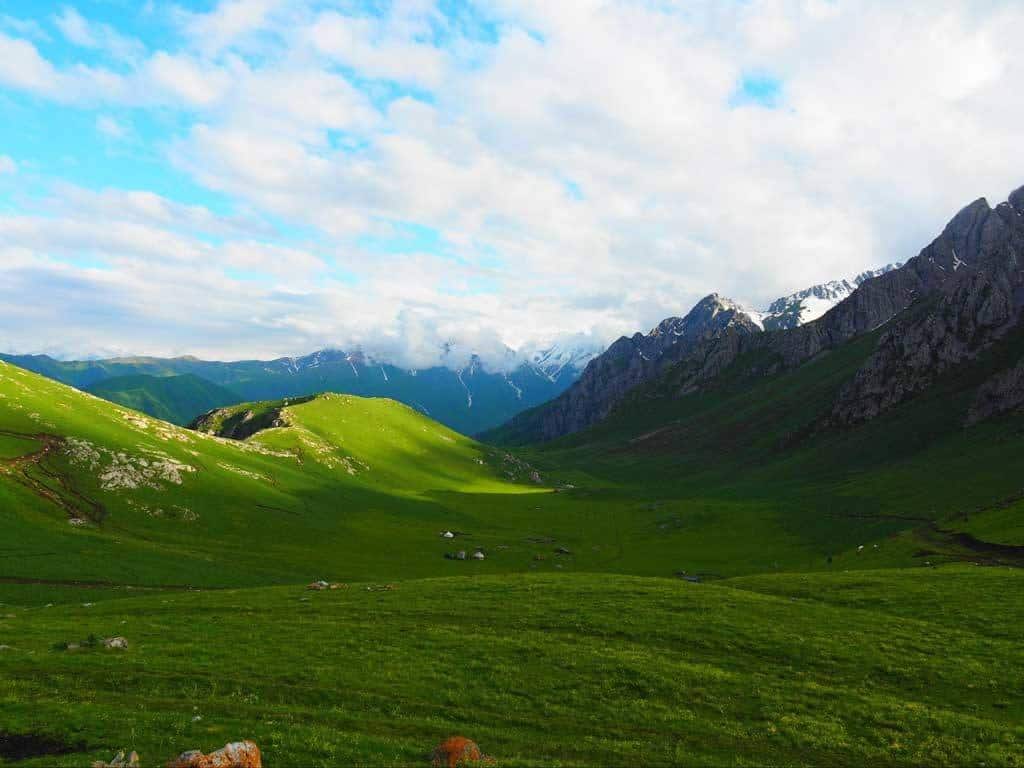
In the pasture, I met Timor and his family. The jailoo at Kum Bell is much smaller than Sari Oi and home to only four families.
Timor’s camp was also much more modest than that of Aiperi and Bekish. With no fence around their camp, the cows roamed freely and their eerie blank stares could be unsettling at the door of the yurt.
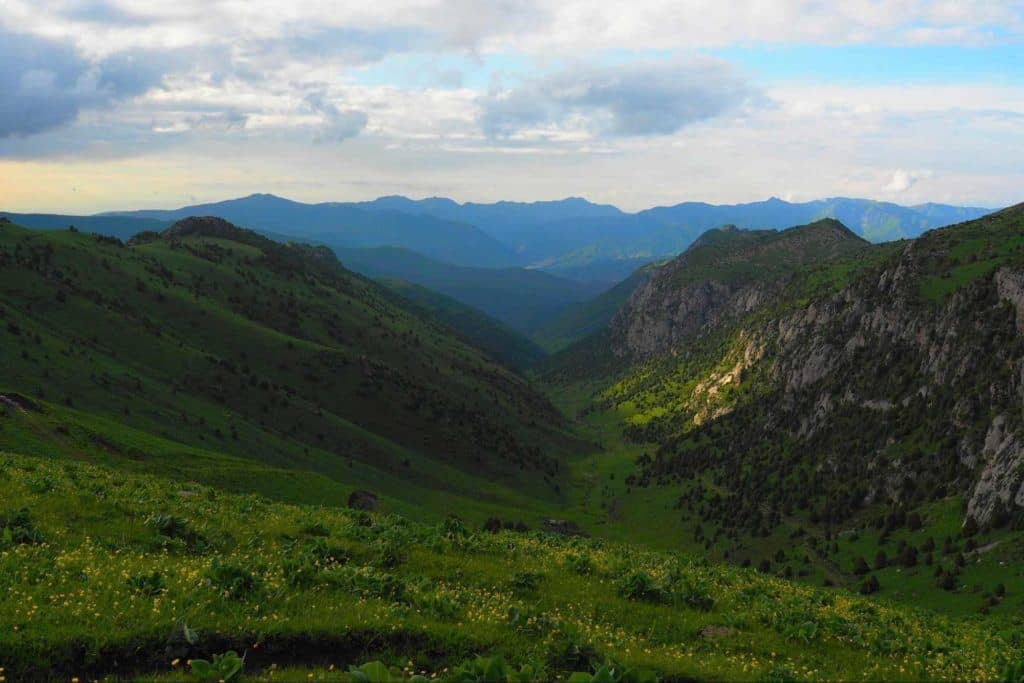
For dinner, we had sheep soup with more kymyz and talked about the weather.
Timor had only come to jailoo a few days prior and it had rained every day.
Their camp consisted of a small yurt and a trailer with two rooms and a stove where the family ate and slept.
Timor’s yurt was smaller and had a more authentic smell (most likely attributable to the proximity of curious cows) and the bathroom was much more of an adventure (thankfully, by this point the kymyz and my stomach had come to an agreement).
Timor invited me to sleep in the trailer with the family where it would be warm by the stove, but I opted to brave the cold in the yurt.
The kymyz and tyshyks again kept me warm.
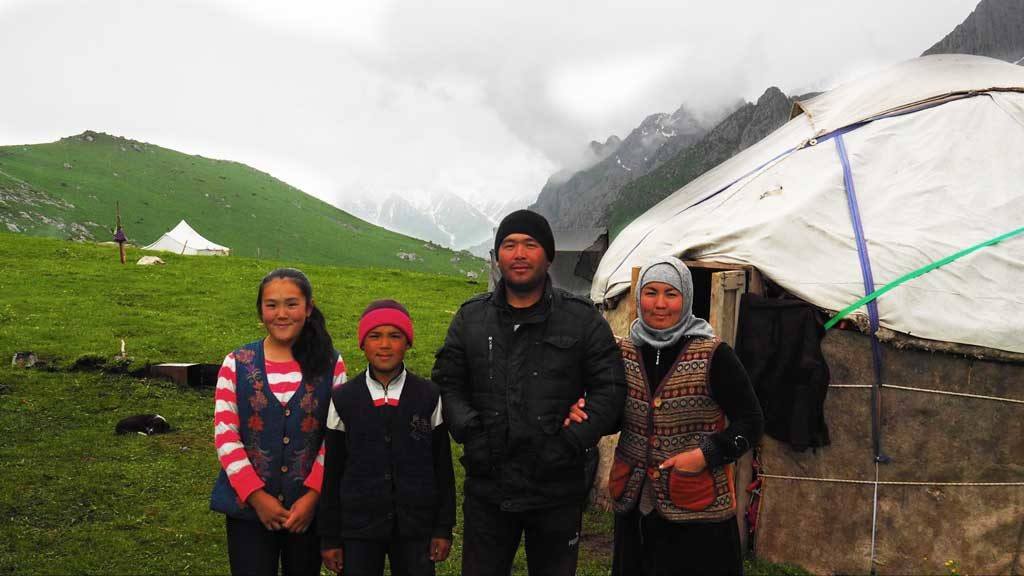
Day Three: Kum Bell to Kara Bulak
After a breakfast of kasha and jam with tea, I said goodbye to Timor and his family and set out for the village of Kara Bulak.
After a short climb up a hill out of the jailoo pasture, the trail into the village was mostly downhill and forgiving.
There is a rocky outcropping on top of the hill that offers a great view of the jailoo and Kum Bell pass.
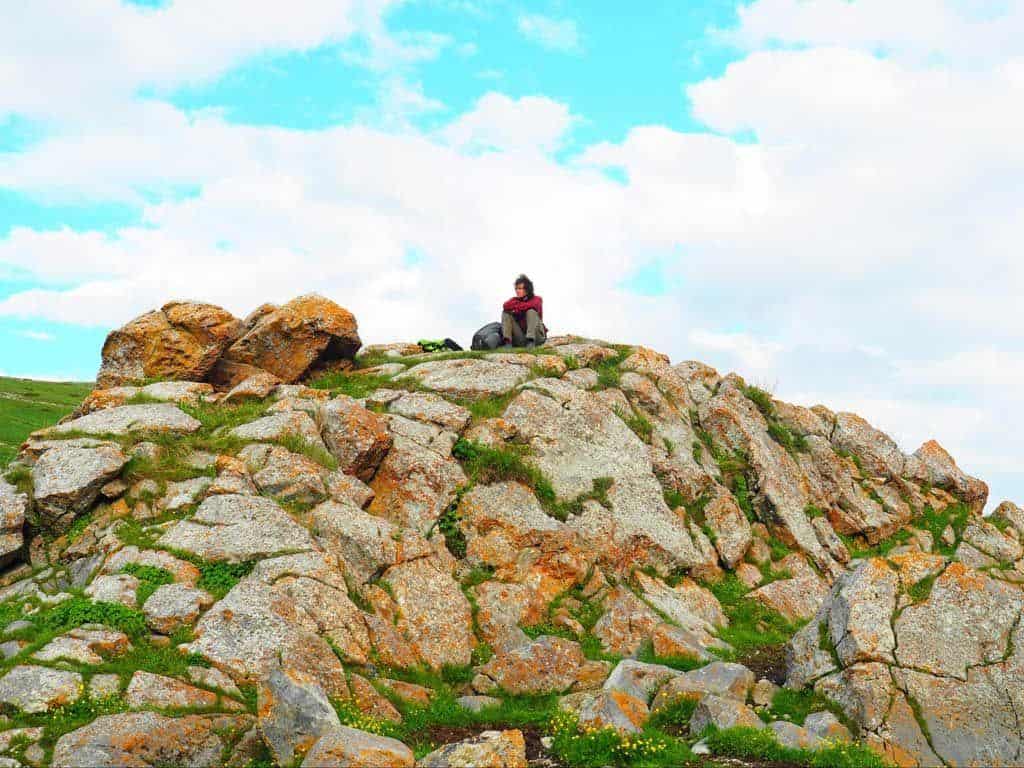
The trail into the village was incredibly muddy from all the rain (more than once threatening to steal my shoes) but fairly straightforward and easy to follow.
I met a group of horse milkers along the way who let me churn the kymyz and sample a fresh batch.
Arriving in Kara Bulak was a relief. To be out of the rain and heading towards a much-needed shower was exciting, but it was tinged with a pang of disappointment.
I would miss these mountains and the sweet effects of the sour kymyz brewed here.
At the road in Kara Bulak there is a bus stop where you can wait for a taxi or marshrutka to Osh.
The ride into town takes about two hours, depending on the driver and the number of stops.
The wait for a ride can vary greatly and is dependent on many variables.
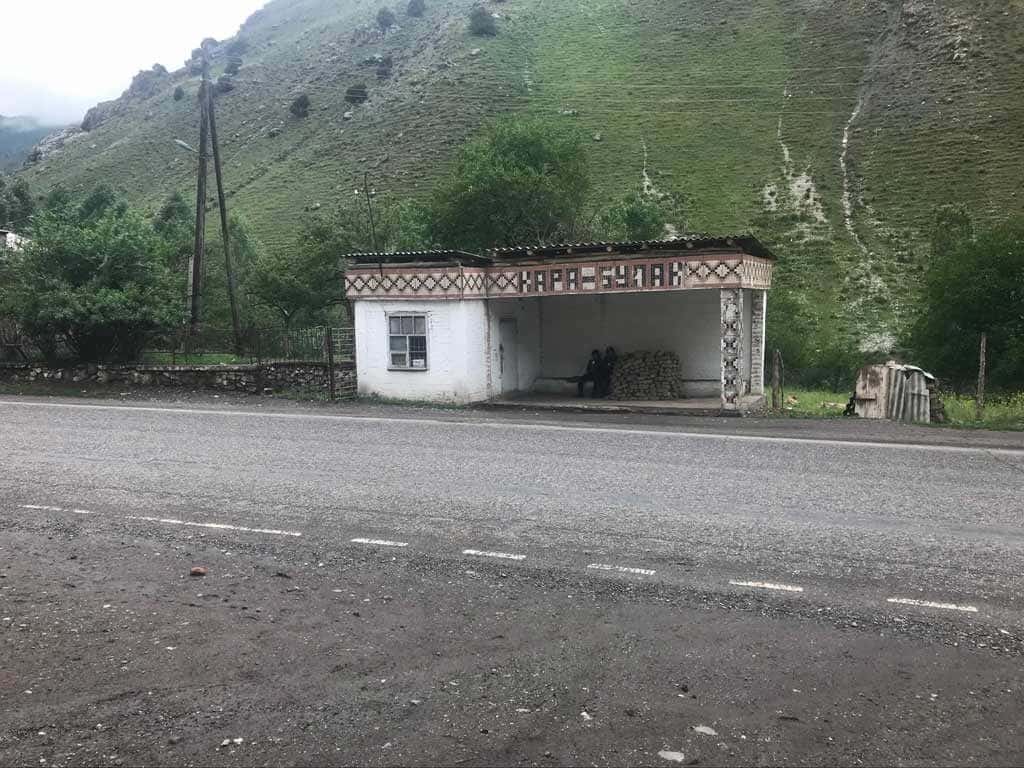
Be a Nomad Trek – Tips and Advice
Food and shelter are provided by local families at Jailoo camps organized through agreements with the CBT, but it is always good to carry extra food and a tarp just in case. Halva makes a good hiking snack.
At jailoo you will see many people milking their horses, and chances are quite a few of them will offer you kymyz. The drink is an acquired taste.
Many Kyrgyz grow up drinking this unique beverage. Use caution when sampling the different varieties of this concoction, but it is not a true jailoo experience without a few bowls of kymyz in front of a warm stove.
April through June are typically rainy months in Kyrgyzstan. Hiking in the early summer is doable, but be prepared.
With the high precipitation, many of the mountain passes will still have snow until July. For those made out of sugar or who prefer dry socks, it is best to do this hike between early July and August.
Hiking in early June I experienced rain, hail, and snow at different points on the trek, with one 24-hour period of continuous precipitation.
Despite this deluge, the hike was still an amazing experience.
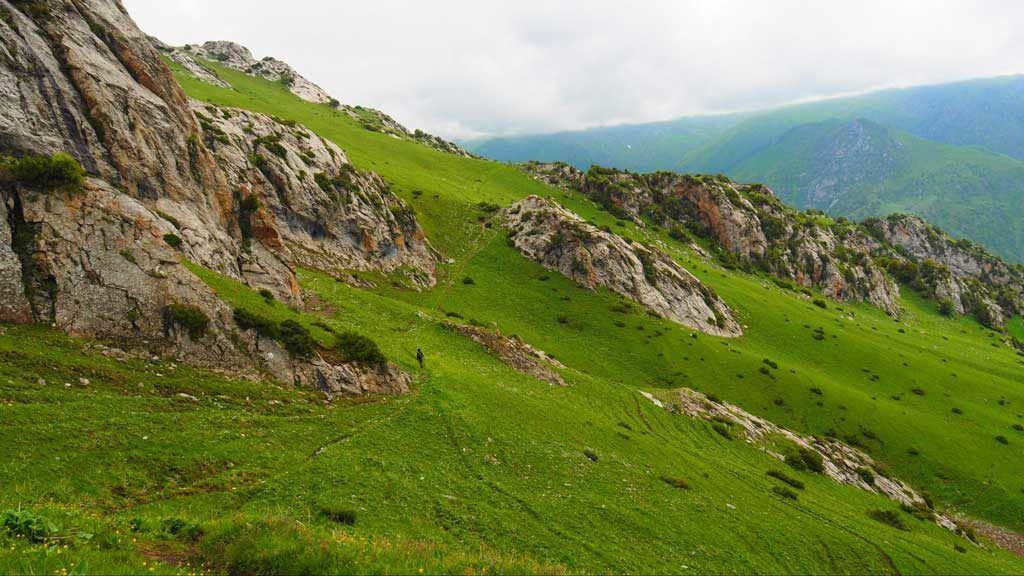
No matter the weather, this hike specifically and this country generally is well worth your time and energy.
Behind every corner, there will something new to amaze or something interesting to learn.
Whether it be geological, cultural, or otherwise, Kyrgyzstan is a country rich in beauty.
Hiking from Chychyk to Kara Bulak on the aptly named “Be a Nomad” trek is a fantastic way to learn about the land and life of Kyrgyzstan.
For more information about this trek and other adventures to be had in the Osh region of Kyrgyzstan consult the Osh Alay CBT .
Historical Context
Kyrgyzstan is one of the former Soviet Republics in Central Asia, bordering Kazakhstan, Uzbekistan, Tajikistan, and China.
Prior to Russian colonization and eventual collectivization, the Kyrgyz people were nomadic, traversing the mountainous terrain of their landlocked country on horseback.
Nomadic heritage is crucial to the modern Kyrgyz identity—this manifests in many ways: games, dress, song and dance, and food.
Nomadic games such as kok buru and oordo are still played regularly in Kyrgyzstan and are celebrated on a large scale every two years with the World Nomad Games festival.
Traditional nomadic dress such as the iconic kalpak hat and cozy kimzir vest are still sported throughout the country.
There are many examples of nomadic history’s influence on modern Kyrgyz culture, but none seem as close to the past as jailoo.
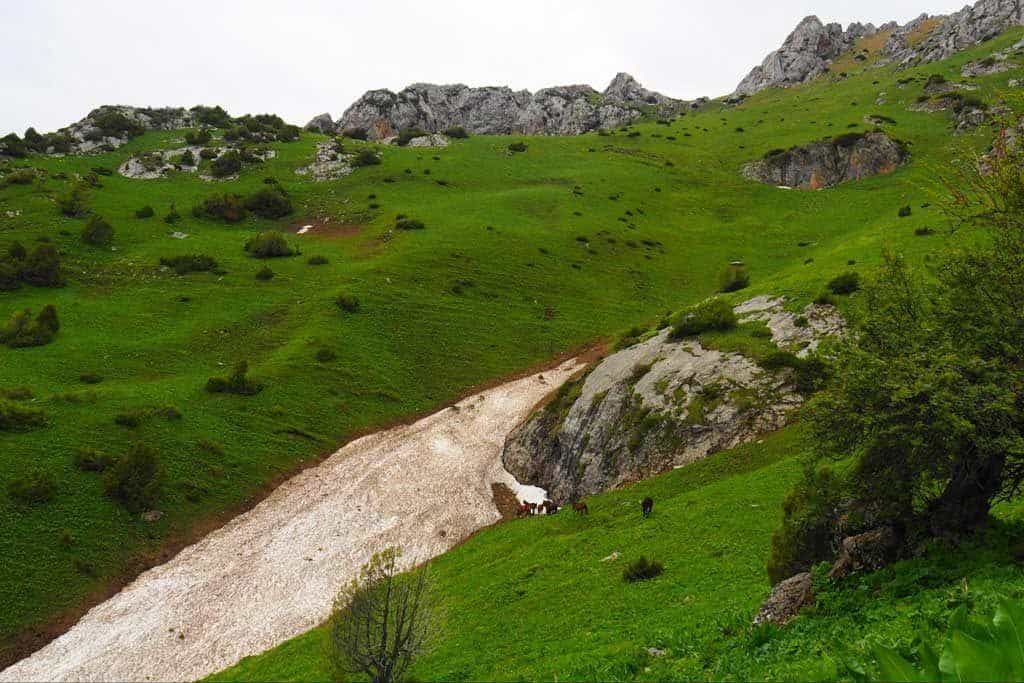
Jailoo is the Kyrgyz word for remote summer yurt camps or pasture. Whole families pack in the late spring and move out to the mountains in the summer for jailoo.
Some have permanent houses built at jailoo, while others will set up tents or yurts known as boz uiy.
At jailoo people will graze their cows, sheep, and horses; prepare traditional Kyrgyz food and drink, especially the prized kymyz; and enjoy the peace and quiet of a simple life in nature.
